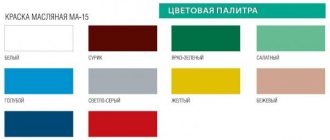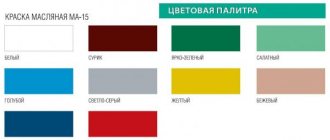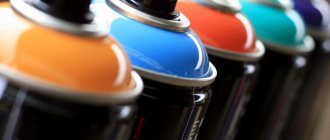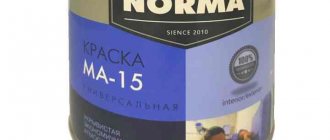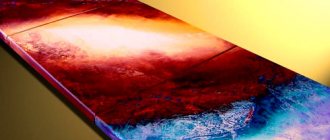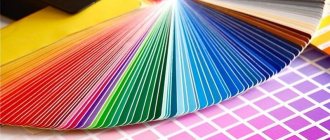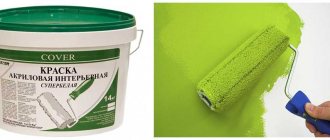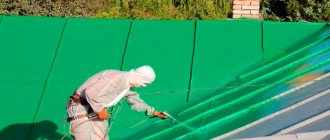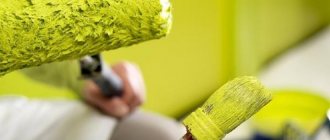Today, textured wall paint is very popular among finishing materials. With its help, you can achieve a relief surface, create a unique texture, and even save on preparatory work. The consistency of the paint is very dense and viscous; when applied, the thickness of the coating is much greater than that of conventional paint. Consequently, the time for preparatory work is reduced, since there is no need to perfectly level the surface of the walls. If desired, this paint can be used for the ceiling.
Main advantages of the material
The texture dye contains a binder acrylic polymer. Thanks to this, the material has the following qualities:
- used for both external and internal work;
- with increased moisture resistance, resistant to temperature fluctuations and precipitation;
- prevents the appearance of mold;
- durable, resistant to chemical influences;
- decorative relief is not modified;
- easy to care for, environmentally friendly;
- used for texturing walls with uneven surfaces;
- By adding color pigment it is possible to achieve any shade.
On video: how to apply the Fur coat effect.
Advantages of painting with a textured mixture
The advantages of textured paint are due to its composition - no solvents or acetone are used in production, which avoids the appearance of an unpleasant odor.
The main advantages of paint:
- Does not contain harmful and toxic components and impurities, so its use does not affect health in any way;
- Due to the fact that the mixture has a thick consistency, you can work with it even without gloves;
- Perfect alignment of the walls is not required - after applying the composition, small cracks and light defects will be hidden;
- Painting walls does not affect the microclimate in the room and does not impair air circulation;
- The coating can withstand high humidity, sudden temperature fluctuations, and is also resistant to the development of fungus;
- Modern manufacturers produce compositions that prevent fire and do not emit toxic substances when heated.
Types of paint and popular brands
Texture paint for walls is divided into categories that differ from each other in composition; with its help, a relief texture is achieved:
- finishing composition for facade surfaces;
- textured painting material for interior decoration;
- universal paint (for interior and exterior use);
- fine grain dye;
- texture paint with coarse composition.
When choosing a material for decorative painting of walls (or for the ceiling), you should not give preference to cheap compositions. First, consult with professional builders who have been performing finishing work for many years.
- "TEX Universal" - paint intended for interior and exterior decoration. Can be used to cover walls in the bathroom and kitchen, as it has increased moisture resistance. The durable composition of the paint allows it to be applied in one layer to cement or concrete surfaces.
- “Optimist” is an acrylic-based material, also intended for exterior and interior use. Its spectacular texture will help hide minor wall defects.
On video: a tutorial on applying decorative materials Optimist.
What colors are there?
Textured wall paint has a rich range of colors, primarily due to its wide tinting options. Most manufacturers of building materials produce paints in a single white color, allowing the buyer to choose the shade that best suits the design.
Important! To be able to repeat the color, order computer tinting in a store, or write down the proportions in grams, selecting the tone manually.
The photo shows pearlescent blue walls in the dining room
Tools and materials for work
To paint walls with texture paint you will need to purchase the following tools and materials:
- acrylic putty;
- primer;
- medium size spatula;
- cuvette (tray) for paint;
- rags;
- rollers (regular and structural);
- scraper;
- foam sponge;
- texture paint;
- workwear.
If you don't have a structure roller, you can easily make one yourself. For this you will need a rough rag. Attach the rag to the roller with thread and get to work.
Preparing walls for painting
The walls must first be cleaned of dirt. This can be done with water, detergent and a cloth. Use a spatula or scraper to remove any remaining old coating. If there are cracks or gouges on the surface, fill them with acrylic putty. Once completely dry, coat the entire wall with primer. Leave to dry for approximately 12 hours.
Preparation before painting is required. Texture material can hide only minor wall imperfections. And the primer will help the paint adhere more firmly to the surface.
Paint is usually sold in powder or liquid form. First, read the instructions, dilute the powder with water using a construction mixer, and mix the finished paint thoroughly. Now you can add color pigment or mix several paints to achieve the desired shade. The pigment should be added while mixing, so the consistency of the paint will be as uniform as possible.
Do a test job before starting painting. Make a few test strokes with a roller on a small piece of cardboard.
Options for the resulting effects
In the process of applying texture paint, you should consider: whether the pigment is selected correctly, whether it is compatible with the dye, and also choose the desired technique for applying the material. Thanks to these components, you can get a unique relief. Conventionally, finishing can be divided into several types:
- Marseille wax. Externally, the surface resembles a combination of tree bark and natural stone. After the texture paint has completely dried, it is necessary to cover the surface with wax. This will give the walls more depth and a luxurious effect.
- Relief. If you want to create a relief transition of small dots and thin strokes on the wall, sawdust and quartz chips will help you with this. Materials should be added to the paint and mixed thoroughly. It is not difficult to adjust the degree of relief. If a minimum surface grain size is required, sand can be added instead of quartz chips. Here everything will depend on your imagination.
- Atacama. To create a three-dimensional wall surface, it is necessary to add fine metal shavings and sand to the acrylic dye in equal proportions. This composition will create an optical illusion. From different corners of the room it will seem to you that the wall has a reflective velvety base filled with volume.
- Mizuri. The most popular type of surface coating. It's quite easy to achieve this effect. Water and modified starch are added to the paint. After drying, the wall becomes glossy. Sometimes a pigment filler is added to the composition, which allows you to achieve a pearly shine. The paint is applied to the wall in chaotic patterns, resulting in the effect of a wet lye.
Before painting, be sure to wear protective clothing and safety glasses. This will protect your eyes and body from paint.
What does it look like in the interior?
The scope of application is extensive. They mainly decorate walls in living rooms, bedrooms, and hallways. But the compositions, resistant to water and washing, are also suitable for kitchens and even bathrooms.
The photo shows imitation rust in loft style
The solution is selected according to the style of the interior: complex Marseille wax will be an excellent backdrop for classic carved furniture or chic Empire and Baroque styles. A more restrained modern style would be suitable for Mizuri in a light neutral shade: white, gray, beige.
In the loft style, atacama would be appropriate: the roughness can imitate concrete, plaster or rust on metal.
The second important factor is the functionality of the room. For children's rooms, choose colored pastels on all walls. Either one of the surfaces is made bright, accent, and the rest are light. Flat “warm” effects are suitable: silk, paper.
In bedrooms, the coverings should be neutral, but it is permissible to play with volume: make pleasant mizuri waves or add the relief of a fur coat or lamb.
For the kitchen, the less relief, the better: dust, dirt, and grease will accumulate on the ledges, which are not easy to clean.
The room where there are no restrictions is the living room. Volume and flatness, bright and calm shades, glossy and matte effect are appropriate. Textured paint is selected according to size: the smaller the room, the lighter and shiny the coating should be.
Using textured paint is always an experiment! It is almost impossible to predict what exactly will happen in the end. But a little skill and a little imagination will help you achieve an excellent result!
Texture paint application technique
The consumption of materials depends on the application of texture paint and the relief of the coating. Methods for applying the coloring composition are varied. For painting work, you can use classic construction tools such as a spray gun and brushes.
The spray gun is used for painting large surfaces. With its help, you can regulate the flow of the jet onto the wall, thereby creating a relief texture. This painting technique can even be used for the ceiling.
Paint brushes are used to paint small areas. With their help, you can create careless or even lines, smooth stains or a smooth glossy surface. Brushes should be purchased with hard bristles. The relief pattern is applied in the third layer.
All these tools are appropriate for light, delicate, classic decorative painting. If you want to make your interior unique, the tools at hand will help you set the desired zest.
The easiest way to create a relief pattern on the wall is to depict chaotic patterns. To do this, apply texture paint to the surface. Without waiting for it to dry, use a dry brush to make strokes. This technique can be used to create a variety of relief patterns. You can create a unique decor on a damp surface using available materials.
If you wrap a roller with thick rope and then walk along a freshly painted wall in different directions, you get the effect of bamboo stems. Various items that at first glance are not compatible with repair are suitable for the job. You can make thin wavy stripes with a regular comb. Also, to create relief, crumpled newspapers, rags, washcloths, etc. will go into the entrance.
Of course, you can greatly simplify the task by purchasing a special texture roller at a hardware store.
Such a tool may consist of two rollers: the first is standard, soft; the second - with a printed pattern. When painting, you can use paint of two colors, so the relief print will stand out more clearly.
Work progress: first paint the wall completely in one color, then moisten the roller in a ditch with paint of a different color and apply strokes to the wall with light movements. Visually demarcate the surface so as not to jump from one strip to another. The wall must be painted in one stage, otherwise gaps and borders will appear in the relief.
During work, the structural roller may become clogged with paint, and then you will not achieve the desired design. To avoid such an incident, periodically rinse it under warm running water.
If the relief pattern will be applied as a second layer, do not forget that the first one must dry completely. To do this, 12 hours must pass between paintings. When the texture painting is completed, all windows and doors in the room should be closed for a day. The temperature must be at least 18 degrees for the paint to adhere tightly to the wall.
The technique of applying texture paint itself is not complicated. To create a pattern you don’t need the skills of an artist, just a little imagination. This decoration is appropriate for the ceiling, room walls and facades. The main thing is that thanks to this painting you will mask small cracks and uneven surfaces.
